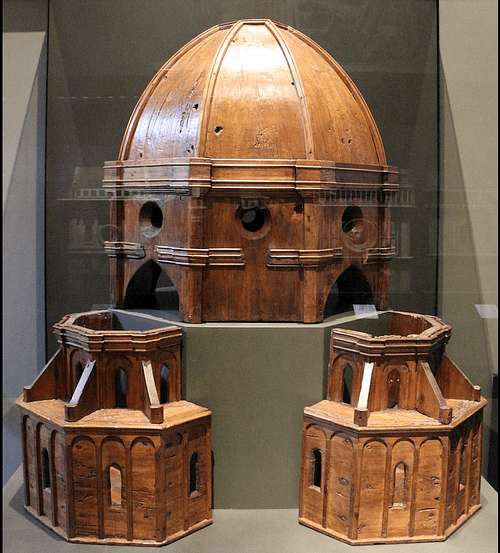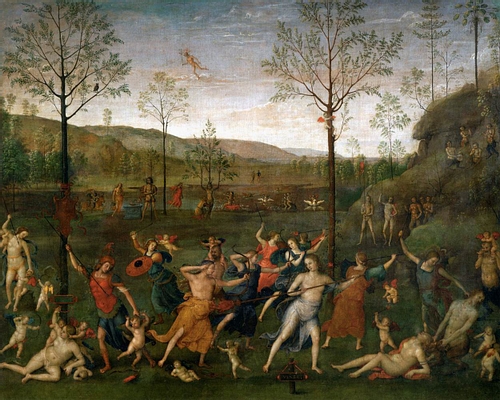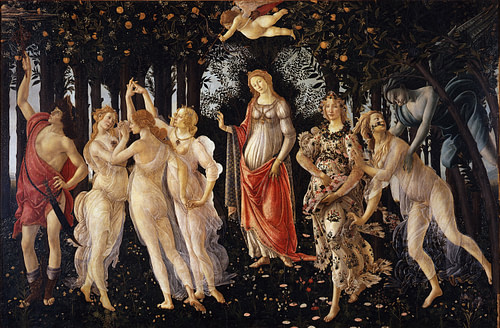During the Renaissance, most works of fine art were commissioned and paid for by rulers, religious and civic institutions, and the wealthy. Producing statues, frescoes, altarpieces, and portraits were just some of the ways artists made a living. For the more modest client, there were ready-made items such as plaques and figurines. Unlike today, the Renaissance artist was often expected to sacrifice their own artistic sentiments and produce precisely what the customer ordered or expected. Contracts were drawn up for commissions which stipulated the final cost, the timescale, the quantity of precious materials to be used, and perhaps even included an illustration of the work to be undertaken. Litigations were not uncommon but, at least, a successful piece helped spread an artist's reputation to the point where they might be able to have more control over their work.

Who Were the Patrons of Art?
During the Renaissance, it was the usual practice for artists to only produce works once they had been asked to do so by a specific buyer in a system of patronage known as mecenatismo. As the skills required were uncommon, the materials costly, and the time needed often long, most works of art were expensive to produce. Consequently, the customers of an artist's workshop were typically rulers of cities or dukedoms, the Popes, male and female aristocrats, bankers, successful merchants, notaries, higher members of the clergy, religious orders, and civic authorities and organisations like guilds, hospitals, and confraternities. Such customers were keen not only to surround their daily lives and buildings with nice things but also to demonstrate to others their wealth, good taste, and piety.
Rulers of cities like the Medici in Florence and the Gonzaga in Mantua wanted to portray themselves and their family as successful and so they were keen to be associated with, for example, heroes of the past, real or mythological. Popes and churches, in contrast, were eager for art to help spread the message of Christianity by providing visual stories even the illiterate could understand. During the Renaissance in Italy, it also became important for cities as a whole to cultivate a certain character and image. There was a great rivalry between cities like Florence, Venice, Mantua, and Siena, and they hoped any new art produced would enhance their status within Italy or even beyond. Publicly commissioned works might include portraits of a city's rulers (past and present), statues of military leaders, or representations of classical figures particularly associated with that city (for example, King David for Florence). For the same reasons, cities frequently tried to poach renowned artists away from one city to work in their city instead. This revolving market of artists also explains why, particularly in Italy with its many independent city-states, artists were always very keen to sign their work and so contribute to their own burgeoning reputation.

Rulers of cities, once they had found themselves a good artist, might keep him at their court indefinitely for a great number of works. A 'court artist' was more than just a painter and could be involved in anything remotely artistic, from decorating a bedroom to designing the liveries and flags of their patron's army. For the very best artists, payment for their work at a particular court could go far beyond mere cash and include tax breaks, palatial residences, patches of forest, and titles. This was just as well because the majority of surviving correspondence we have from such artists as Leonardo da Vinci (1452-1519 CE) and Andrea Mantegna (c. 1431-1506 CE) involves respectful but repeated demands for the salary their illustrious, yet tight-fisted patrons, had originally promised them.
Modest art, say a small votive statue or plaque, was within the means of more humble citizens, but such purchases would have been only for special occasions. When people got married, they might employ an artist to decorate a chest, some parts of a room, or a fine item of furniture in their new home. Relief plaques to leave in churches in thanks for a happy occurrence in their lives was a common purchase, too, for ordinary folk. Such plaques would have been one of the few types of art produced in larger quantities and made readily available 'over the counter'. Other options for cheaper art included secondhand dealers or those workshops which offered such minor items as engraving prints, pennants, and playing cards which were ready for sale but could be personalised by, for example, adding a family coat of arms or a name to them.
Expectations & Contracts
Whoever the client of Renaissance art, they could be very particular about what the finished article looked like. This was because art was not merely produced for aesthetic reasons but to convey meaning, as mentioned above. It was no good if a religious order paid for a fresco of their founding saint only to find the finished artwork contained an unrecognisable figure. Simply put, artists could be imaginative but not go so far from convention that nobody knew what the work meant or represented. The re-interest in classical literature and art which was such an important part of the Renaissance only emphasised this requirement. The wealthy possessed a common language of history regarding who was who, who did what, and what attributes they had in art. For example, Jesus Christ has long hair, Diana carries a spear or bow, and Saint Francis must have some animals nearby. Indeed, a painting packed with classical references was highly desirable as it created a conversation piece for dinner guests, allowing the well-educated to display their deeper knowledge of antiquity. The Primavera painting by Sandro Botticelli (1445-1510 CE), commissioned by Lorenzo di Pierfrancesco de' Medici, is an excellent and subtle example of this common language of symbolism.
As a consequence of the expectation of patrons, and in order to avoid disappointment, contracts were commonly drawn up between artist and patron. The design, whether of a statue, painting, baptistery font, or tomb, might be agreed on in detail beforehand. There could even be a small scale model or a sketch made, which then became a formal part of the contract. Below is an extract from a contract signed in Padua in 1466 CE which included a sketch:
Let it be manifest to anyone who will read this paper that Mr Bernardo de Lazzaro had contracted with Master Pietro Calzetta, the painter, to paint a chapel in the church of St. Anthony which is known as the chapel of the Eucharist. In this chapel he is to fresco the ceiling with four prophets or Evangelists against a blue background with stars in fine gold. All the leaves of marble which are in that chapel should also be painted with fine gold and blue as should the figures of marble and their columns which are carved there…In the said altarpiece, Master Pietro is to paint a history similar to that in the design which is on this sheet…He is to make it similar to this but to make more things than are in the said design…Master Pietro promises to finish all the work written above by next Easter and promises that all the work will be well made and polished and promises to ensure that the said work will be good, solid, and sufficient for at least twenty-five years and in case of any defect in his work he will be obliged to pay both the damage and the interest on the work…
(Welch, 104)
The fees for a project were set out in the contract and, as in the example above, the completion date was established, even if negotiations might continue long after to amend the contract. Missing the promised delivery date was perhaps the most common reason for litigation between patrons and artists. Some works necessitated the use of expensive materials (gold leaf, silver inlay, or particular dyes, for example) and these might be limited in quantity by the contract to avoid the artist overindulging and going over budget. In the case of goldwork or a fine marble sculpture, the minimum weight of the finished work could be specified in the contract. For paintings, the price of the frame might be included in the contract, an item that frequently cost more than the painting itself. There might even be a get-out clause that the patron could avoid paying altogether if the finished piece did not gain favour with a panel of independent art experts. After a contract was signed, a copy was each kept by the patron, artist, and public notary.

Following the Project
Once the terms and conditions were settled, the artist might still face some interference from his patron as the project developed into a reality. Civic authorities could be the most demanding of all patrons as elected or appointed committees (opere) discussed the project in detail, perhaps held a competition to see which artist would do the job, signed the contract, and then, after all that, established a special group to monitor the work throughout its execution. A particular problem with opere was that their members changed periodically (although not their chief, the operaio) and so commissions, although not perhaps cancelled, could be seen as less important or too expensive by different officials from those who originally started the project. Fees became an ongoing issue for Donatello (c. 1386-1466 CE) with his Gattamelata in Padua, a bronze equestrian statue of the mercenary leader (condottiere) Erasmo da Narni (1370-1443 CE), and this despite Narni having left in his will a provision for just such a statue.
Some patrons were very particular indeed. In a letter from Isabella d'Este (1474-1539 CE), wife of Gianfrancesco II Gonzaga (1466-1519 CE), then ruler of Mantua, to Pietro Perugino (c. 1450-1523 CE), the painter was left very little margin for imagination in his painting the Battle between Love and Chastity. Isabella writes:
Our poetic invention, which we greatly want to see painted by you, is a battle of Chastity and Lasciviousness, that is to say, Pallas and Diana fighting vigorously against Venus and Cupid. And Pallas should seem almost to have vanquished Cupid, having broken his golden arrow and cast his silver bow underfoot; with one hand she is holding him by the bandage which the blind boy has before his eyes, and with the other she is lifting her lance and about to kill him…
the letter continues like this for several paragraphs and concludes with:
I am sending you all these details in a small drawing so that with both the written description and the drawing you will be able to consider my wishes in this matter. But if you think that perhaps there are too many figures in this for one picture, it is left to you to reduce them as you please, provided that you do not remove the principal basis, which consists of the four figures of Pallas, Diana, Venus and Cupid. If no inconvenience occurs I shall consider myself well satisfied; you are free to reduce them, but not to add anything else. Please be content with this arrangement.
(Paoletti, 360)

Portraiture must have been a particularly tempting area for patron interference and one wonders what customers thought of such innovations as Leonardo da Vinci's three-quarter view of his subjects or the absence of conventional status symbols like jewellery. One of the bones of contention between the Pope and Michelangelo (1475-1564 CE) while he was painting the Sistine Chapel ceiling was that the artist refused to let his patron see the work until it was completed.
Finally, it was not unusual for patrons to appear somewhere in the work of art they had commissioned, an example being Enrico Scrovegni, kneeling in the Last Judgement section of Giotto's frescoes in the Scrovegni Chapel in Padua. Sandro Botticelli (1445-1510 CE) even managed to get in a whole family of senior Medici in his 1475 CE Adoration of the Magi. At the same time, the artist might put themselves in the work, see, for example, the bust of Lorenzo Ghiberti (1378-1455 CE) in his bronze panelled doors of Florence's Baptistery.
Post-Project Reaction
Despite the contractual restrictions, we can imagine that many artists tried to push the boundaries of what had been previously agreed upon or simply experimented with novel approaches to a tired subject matter. Some patrons, of course, may even have encouraged such independence, especially when working with more famous artists. However, even the most renowned artists could get into trouble. It was not unknown, for example, for a fresco not to be appreciated and so be painted over and then redone by another artist. Even Michelangelo faced this when completing his frescoes in the Sistine Chapel. Some of the clergy objected to the amount of nudes and proposed to replace them entirely. A compromise was settled on and 'trousers' were painted on the offending figures by another artist. However, the fact that many artists received repeat commissions would suggest that patrons were more often satisfied than not with their purchases and that, like today, there was a certain respectful deference for artistic license.
Patrons certainly could be disappointed by an artist, most commonly by them never finishing the work at all, either because they walked out over a disagreement on the design or they simply had too many projects ongoing. Michelangelo fled Rome and the interminable saga that was the design and execution of the tomb of Pope Julius II (r. 1503-1513 CE), while Leonardo da Vinci was notorious for not finishing commissions simply because his overactive mind lost interest in them after a while. In some cases, the master artist might have deliberately left some parts of the work to be finished by his assistants, another point which a wise patron could guard against in the original contract. In short, though, litigations for breaches of contract were not an uncommon occurrence and, just like commissioning an artist today, it seems that a Renaissance patron could be delighted, surprised, perplexed, or downright outraged at the finished work of art they had paid for.






